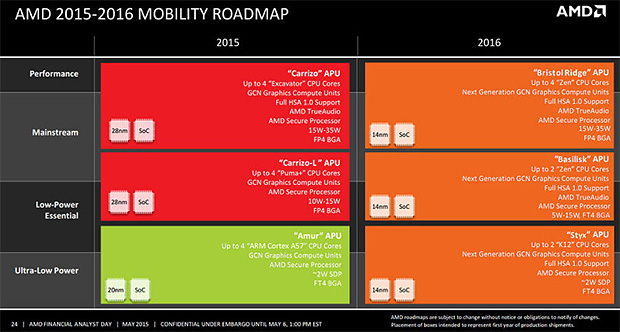It took AMD quite a while to get Carrizo to market since it first time officially talked about it in November last year. Carrizo is a 28nm SoC with up to four Excavator CPU cores, GCN graphics, Full HSA 1.0 support, True Audio, AMD secure processor and 15W to 35W TDP. It comes in FP4 BGA socket and aims at performance and mainstream notebooks. In 2016 it will be replaced by Bristol Ridge APU that comes in 14nm, with up to four Zen CPU cores.
Bristol Ridge also has the next generation graphics, probably Greenland that we mentioned before, full HAS 1.0 support, AMD True Audio, AMD secure processor. This is a 14nm Soc with the same FP4 BGA socket and once can hope that it will work in Carrizo notebook motherboards. This would simplify future design wins and made them less expensive. Bristol Ridge also has a 15W to 35W thermal envelope and since 14nm SoC can theoretically place up to four times the transistor count than on a 28nm die, so we expect a huge performance leap in mobile computing with Bristol Ridge, in 2016.
The Carrizo L APU is not a proper Carrizo as it doesn’t have Excavator cores - it comes with up to 4 Puma cores instead. It comes with GCN graphics compute units, AMD secure processor and 10W to 15W TDP, but it also uses the FP4 BGA and fits Carrizo motherboard designs. This will reduce the development cost for manufacturers and Carrizo L targets the lower mainstream and low power essential designs. Carrizo L will get replaced by Basilisk APU, something that AMD plans to use for desktop small form factor designs and essential designs too. 
Basilisk in mobile versions has up to 2 Zen CPU cores, next generation graphics, HSA 1.0, True Audio, AMD secure processor and 5W to 15W thermal design. Basilisk uses the new FT4 BGA socket which means it will require a new motherboard. Since this is a 14nm APU we expect huge performance leap over Carrizo L.
AMD has one more exciting part for 2015 manufactured in 20nm. AMD executives have confirmed back in July 2014 that there will be some 20nm APUs in 2015. It is called Amur APU and this is a a 20nm SoC based on up to four ARM Cortex A57 cores. Amur also combines GCN graphics compute units with the ARM architecture and it comes with AMD secure processor. Last time we mentioned Amur, it was scheduled to come in Q3 2015. Since this is a sub 2W SPD part, it targets the Ultra-Low power. Because it is an ARM design, we expect that it will go after tablets and possibly even gaming consoles. It will rely on Android, as Microsoft made it clear that Windows 10 won't run on ARM. We are anxious to see Amur design wins and learn whether or not some of them can ship in the next few months. Looking at ARM it makes us wonder how hard it would be for MediaTek to combine AMD GPU with its ARM cores, something that we already mentioned here.
Amur 20nm ARM A57 this year
The successor of Amur in 2016 is 14nm SoC codenamed Styx APU. It has up to 2 K12 CPU cores and this might imply that K12 offers a lot of performance per core. Remember, Denver Tegra is also a dual-core design and it didn’t stop Google to use it for Nexus 9, its first Android 5.0 tablet. It performs rather well.
Styx APU has a next generation graphics compute unit, full HSA 1.0 support, AMD secure processor and the same FT4 BGA socket that we saw with Amur designs. This implicates that Styx might be platform combatable with Amur designs, but it is too early to confirm this.
It will come down to the fact that AMD needs these 14nm mobile parts on market as soon as possible. If it manages to have them ready for back to school or early summer 2016, it will be good for them. Let's hope that Zen and K12 can be on time, for a change.




